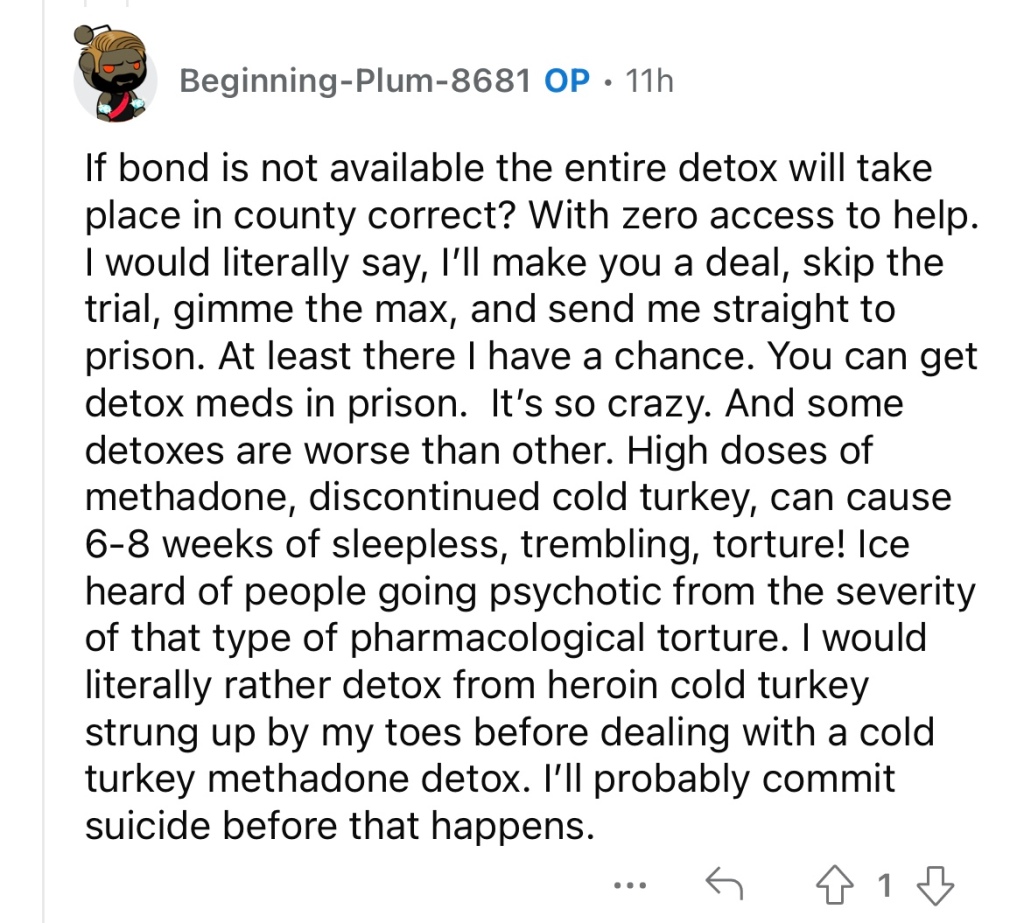I was poking around on Reddit, because I’m a glutton for punishment, when I found this on r/prison:

I’m immediately annoyed that a drug addict thinks a working person owes him a free detox. Why do I have to solve your problems? In school, we called this a “natural consequence.” Get addicted and arrested? Detox cold turkey. That way you learn.
Then, he calls medical detox a basic human right (according to who?) and I’m feeling even more annoyed because now it sounds like he wants this service given to him for free. You know, because all you have to do to get a free medical service is call it a basic human right. Finally, he finished off by saying anyone who doesn’t want to pay for his rehab isn’t even human and should be ashamed.
Before I even have a chance to make these points I discover that the writer has anticipated them. He even doubles down:

Let people pay for their own rehab if they want to? That seems reasonable, until you remember that people absolutely can pay for their own rehab, and do it all the time. He’s saying something different. He wants to be let out for rehab, that’s what he means by “freedom.” My annoyance levels rapidly rising, I scroll down to comment.
But before I get there, I find more from the original poster.

Now his descriptions are getting vivid and he’s starting to bring himself into the discussion. The situation is shifting from annoying person demanding free stuff to something a little more sad.

Now I get it. This guy is a heroin addict. He’s going to jail and he’s worried about getting dopesick. No, he’s terrified of getting dopesick.
He’s not blaming himself for trying the drug, getting addicted, and committing a crime. He’s not even reflecting on his own role. He’s not writing in r/ifuckedup. I read everything he wrote. He’s scared of withdrawals and wants a bailout.
Viewed that way, we can feel compassion for the addict and understand where he’s coming from. His desire for free rehab isn’t coming from his ideas about fairness or the criminal justice system. He’s just really scared of heroin withdrawals and is looking for a place to channel that.
The sad thing is that some people who read his stuff aren’t going to pick up on the nuance. Readers may be taken in because they think he’s arguing altruistically when really he’s frightened and wants something for nothing.
I think compassion requires something more than just free rehab for this addicted criminal. They say that you can’t quit heroin until you hit rock bottom. I hope he can hit rock bottom because it’s a step on the way to sobriety. I hope he has a rough withdrawal period and decides to quit. Throwing money at him won’t give him a chance to deal with the consequences of addiction. It may even rob him of the motivation he needs to go sober.
Maybe another Redditor put it best:

Bonus Stupidity
Here’s some other uninformed things I found along the way.

Read a RAP sheet for any prisoner you want. I challenge you to find one who went there as a first stop for a minor offense. There are diversion laws that explicitly forbid this. And the system is built to give you multiple chances to go straight before you go to prison.

They idea that prison is profitable is so astoundingly inaccurate that I can only laugh.

This person probably had to pay just a small part of the cost of his own jail stint and look how mad he is. Are you just as mad? Because you paid for him too.




